Washington DC, Sydney, Vancouver, Manchester, Hong Kong; all places that hold great memories for members of the World 100 Reputation Network who were able to truly expand their horizons by attending our annual conference at the great universities in those cities.
This year, we should have been at the University of Melbourne in that great southern metropolis – regularly voted the most liveable city in the world. Stimulating conversation and other learning experiences – just how do they make such great wine? – awaited us. Until the pandemic intervened.
Knowing that W100 members value the networking opportunities – by that, I mean seeing old friends and making new ones – provided by the conference, more than any of our other activities, we instantly resolved to push ahead with a virtual meeting as soon as it became clear that no one would be getting on a plane to Melbourne.
“We’ll just deliver it online – everyone’s doing it now!” we said. Quite quickly, however, the challenges of delivering something that people would want – and be able – to engage with started to become apparent.
Finding a spot in busy times
The first issue to address was the fact that when people travel around the world for a conference, a huge benefit is that they are out of the office and can spend ‘quality’ time engaging with like-minded colleagues they normally see. With most working from home – and super busy dealing with the communications challenges of the pandemic response – we couldn’t really expect people to dedicate 2 full days to the conference.
So our W100 Committee came up with the great idea of spreading the conference sessions across a week and branding it a ‘Festival of Reputation’. That made even more sense when we realised that this format could also incorporate the THE Leadership & Management Summit, where we’d been asked to run a W100 session alongside the launch of the Reputation Rankings.
Conference attendees have had the opportunity to spend a couple of hours at a time engaging with conference sessions; but then perhaps perusing a session they may have missed which is available on demand.

The Time Zone Conundrum
The next issue was perhaps the one that caused most complications: time zones. We are a global network, with members in Australia (UTC + 10), Asia (UTC + 8), Europe (UTC +1), the UK & Ireland (UTC) and North America (variously UTC –5, 7 and 8).
So we spent many, many hours trying to work out a timetable that would provide opportunities for live engagement for all our members; and then ensuring that live sessions would be recorded so they would be available on demand. To make some of our sessions truly global, we also did some pre-recording which involved at least one party (us) working through part of the night.
To Zoom or not to Zoom
The next issue was the technology. The whole world of work – as well as leisure – has been adapting to the online experience, so after exploring bespoke virtual conference platforms, we decided that running the whole event on Zoom should work. With most colleagues around the world comfortable with the technology, the main worries then became capacity and – above all – the strength of our own home broadband networks.
Speaking of challenges…
Getting the speakers was the next challenge. We have always aimed for a mix of external experts and leaders in reputation amongst our own members. This year, the big challenge was just how busy people are: colleagues in universities, in particular, have very limited bandwidth at the moment to devote time to preparing and delivering sessions, even though they don’t have to spend time travelling.
We were delighted that so many of our members stepped up to the plate to share their experience. And that they have been very flexible with time zones, pre-recording and joining for live Q&As. It was great too to get engagement from our friends at Times Higher Education and The Chronicle for Higher Education, who have put on really interesting sessions. Our final plenary, with Astra Zeneca – a company working with universities to play a key role in addressing the pandemic – will be a great way to finish the conference.
The Social Element
One final challenge was to see whether we could in any way replicate the benefits that you get from informal engagement at conferences – those conversations over coffee or lunch (and the half-remembered ones from the bar).
It would be fair to say that this was the most intractable issue; but we did provide some opportunities through organizing more informal “Covid Surgeries’ giving small groups the chance to talk about particular issues away from the conference sessions. Our earlier ideas of setting up social online gatherings with for example, Australians drinking coffee and Canadians having wine, didn’t really come to fruition. Although we do know that some old friends made strenuous efforts to continue those half-remembered conversations from the bar in Manchester or Belfast last year.
How was it for you?
So how has the conference worked? Well, so far (fingers crossed…) none of the technology has fallen over – barring a few broadband problems. No one has been interrupted when talking by a small child or animal, and the Q & A function has been busy during sessions.
The timezone issue has thrown up some challenges – notably that the W100 team has worked a couple of 15 hour days during the conference to accommodate the timetable. We hope you didn’t notice the eyes drooping a couple of times.
Ultimately, it will be for members to decide whether the conference has been beneficial. Do let us know – and tell us what we can do better. We will be sending out a feedback form at the end of the week. We really hope that we can be back in Melbourne in November 2021, but if not, we’ll do it all again online.



